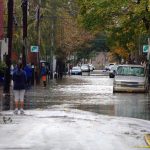New Jersey Future Blog
Voters in S. Hunterdon Approve Regional School District
September 25th, 2013 by Elaine Clisham
In a Sept. 24 referendum, voters in a township, a city and a borough in southern Hunterdon County overwhelmingly approved the creation of a single regional preK-12 school district to replace their four current districts. According to unofficial totals posted on the county’s website, the referendum, open to voters in Lambertville, Stockton and West Amwell, passed by a margin of almost 6 to 1, with almost 30 percent of registered voters casting a ballot. (By comparison, 9 percent of eligible voters statewide turned out in the August primary for U.S. Senate.)
The vote is important not just to the affected municipalities but to the rest of the state, for two reasons: First, it provides a template for the process other areas can follow should they choose to explore school-district consolidation; and second, it will enable better land-use decision-making in the affected municipalities.
New Jersey Future has been strongly supportive of school-district regionalization efforts. The structure and funding of school districts on a town-by-town basis inevitably leads to what has become known as the “ratables chase” – the push to attract commercial rather than residential development in order to reap the property tax benefits without having to provide extensive (and expensive) services, including schools. Expanding the geographic area over which a school district derives its funding will almost certainly lead to more rational land-use decisions, including siting commercial development where it’s most appropriate rather than in the town that lobbied hardest for it. The same phenomenon may also open the way for more residential development to occur, bringing with it the possibility of reduced housing prices as supply increases. And while these three municipalities may not be facing the kinds of development pressures at the moment that other areas of the state have seen, they now have the framework in place going forward to be able to make those decisions based on more sensible criteria.
The referendum was the culmination of almost three years’ worth of work by the school districts and a special regionalization committee, beginning with a comprehensive study to evaluate the academic, operational and financial implications of various regionalization scenarios. The committee placed only one scenario on the ballot: the one that included tax equalization calculations most nearly equally beneficial to residents in all three municipalities.
The initiative faced headwinds on several fronts, including the fact that, in order for regionalization to occur, voters had to approve two separate ballot measures with potentially confusing wording: the first measure would dissolve the existing regional high school district, and the second would merge and expand the three existing primary districts.
However, that and other fears turned out to be groundless. All those involved – the boards of education, the school superintendents, the regionalization committee, the local and county officials who lent their support, and the residents – are to be congratulated on their willingness to be pioneers in changing the landscape of local governance.

















